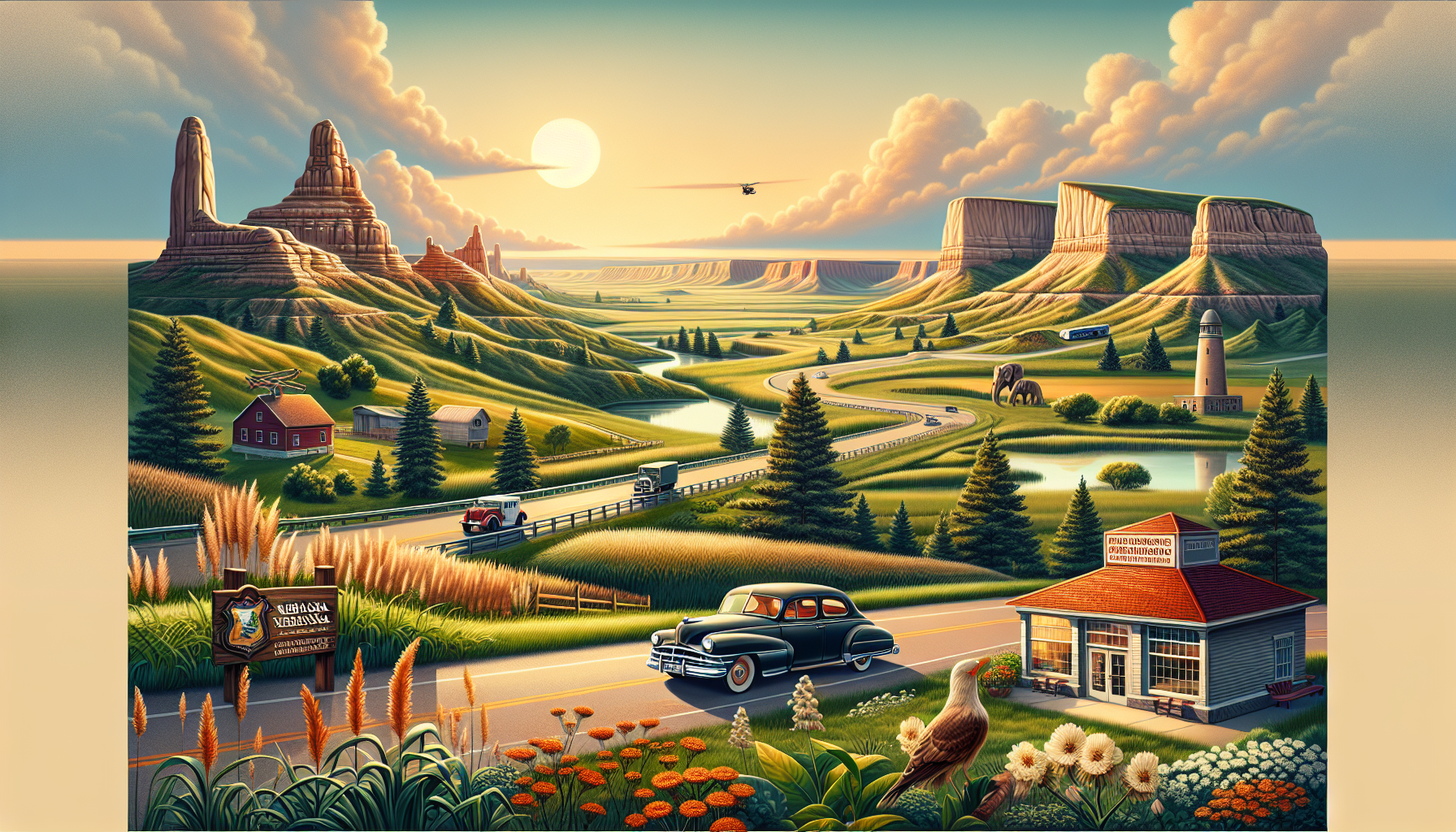Bentonite Deposits in Nebraska

As one travels through Nebraska, it becomes apparent that the state's unique geology has given rise to a multitude of fascinating natural formations. One of the most interesting of these is the abundance of bentonite deposits, which can be found throughout the state's vast plains and badlands regions. Bentonite is a type of absorbent clay that is formed through the alteration of volcanic ash deposits. This process typically occurs in shallow, alkaline lakes or swamps, where the ash is subjected to intense weathering and erosion. Over time, the ash is transformed into a highly porous, absorbent clay that can expand up to 15 times its original size when exposed to water.
One of the most famous bentonite deposits in Nebraska is the Milburn formation, located in Cherry County, near the town of Ainsworth. This formation is notable for its high-quality bentonite deposits, which are prized for their exceptional absorbency and are widely used in the manufacture of cat litter, cosmetics, and pharmaceuticals. The Milburn formation is part of the larger White River Group, a Cenozoic-era formation that spans across western Nebraska and parts of South Dakota and Wyoming. This region is home to some of the most significant bentonite deposits in the country, with the states of Nevada, Wyoming, and Montana also boasting substantial reserves.
The precise location of bentonite deposits within Nebraska can often provide clues to the state's complex geological history. For example, the discovery of bentonite deposits in the Sandhills region, near the town of Alliance, has shed light on the region's unique geology. The Sandhills are a vast, sandy plain that covers much of central Nebraska, and the presence of bentonite deposits in this area suggests that the region was once home to a network of shallow lakes and swamps. These water bodies would have provided the perfect conditions for the alteration of volcanic ash, leading to the formation of bentonite.
In addition to the Milburn formation, Nebraska is also home to several other significant bentonite deposits, including the Arikaree Group and the Ogallala Group. The Arikaree Group is a Miocene-era formation that covers a large area of western Nebraska, including parts of the Ogallala Aquifer Region. This formation is notable for its diverse geology, which includes not only bentonite deposits but also layers of sand, silt, and limestone. The Ogallala Group, on the other hand, is a Pliocene-era formation that covers much of central and western Nebraska. This formation is known for its rich fossil deposits, including those of ancient rhinos, camels, and elephants.
Bentonite deposits have a wide range of uses, from the manufacture of clay products, such as cat litter and ceramic pottery, to the stabilization of soil and the treatment of wastewater. In Nebraska, the clay is often extracted using open-pit mining techniques, which involve the removal of soil and rock to reveal the underlying bentonite deposits. The clay is then processed and ground into a fine powder, which can be used in a variety of applications.
While bentonite deposits are a significant natural resource, their extraction and use can also have environmental impacts. For example, the mining process can disrupt local ecosystems and cause soil erosion, which can lead to the loss of biodiversity and the degradation of water quality. As such, it is essential that bentonite extraction is carried out in a responsible and sustainable manner, with careful planning and mitigation measures in place to minimize environmental harm.
In conclusion, bentonite deposits are a fascinating aspect of Nebraska's geology, with significant implications for our understanding of the state's complex natural history. From the Milburn formation to the Ogallala Group, Nebraska's bentonite deposits offer a window into the state's unique geological past and its ongoing environmental processes. As we continue to learn more about these deposits and their role in shaping the state's natural landscape, we are reminded of the importance of responsible resource management and the need to balance human activity with environmental stewardship.
Traveling through Nebraska, bentonite deposits offer a glimpse into the state's rich geological heritage. As we explore the state's vast plains, badlands, and river systems, we are reminded of the complex interplay between geology, climate, and living organisms. By learning more about bentonite deposits and their significance, we can deepen our appreciation for the natural world and our place within it.
One of the most famous bentonite deposits in Nebraska is the Milburn formation, located in Cherry County, near the town of Ainsworth. This formation is notable for its high-quality bentonite deposits, which are prized for their exceptional absorbency and are widely used in the manufacture of cat litter, cosmetics, and pharmaceuticals. The Milburn formation is part of the larger White River Group, a Cenozoic-era formation that spans across western Nebraska and parts of South Dakota and Wyoming. This region is home to some of the most significant bentonite deposits in the country, with the states of Nevada, Wyoming, and Montana also boasting substantial reserves.
The precise location of bentonite deposits within Nebraska can often provide clues to the state's complex geological history. For example, the discovery of bentonite deposits in the Sandhills region, near the town of Alliance, has shed light on the region's unique geology. The Sandhills are a vast, sandy plain that covers much of central Nebraska, and the presence of bentonite deposits in this area suggests that the region was once home to a network of shallow lakes and swamps. These water bodies would have provided the perfect conditions for the alteration of volcanic ash, leading to the formation of bentonite.
In addition to the Milburn formation, Nebraska is also home to several other significant bentonite deposits, including the Arikaree Group and the Ogallala Group. The Arikaree Group is a Miocene-era formation that covers a large area of western Nebraska, including parts of the Ogallala Aquifer Region. This formation is notable for its diverse geology, which includes not only bentonite deposits but also layers of sand, silt, and limestone. The Ogallala Group, on the other hand, is a Pliocene-era formation that covers much of central and western Nebraska. This formation is known for its rich fossil deposits, including those of ancient rhinos, camels, and elephants.
Bentonite deposits have a wide range of uses, from the manufacture of clay products, such as cat litter and ceramic pottery, to the stabilization of soil and the treatment of wastewater. In Nebraska, the clay is often extracted using open-pit mining techniques, which involve the removal of soil and rock to reveal the underlying bentonite deposits. The clay is then processed and ground into a fine powder, which can be used in a variety of applications.
While bentonite deposits are a significant natural resource, their extraction and use can also have environmental impacts. For example, the mining process can disrupt local ecosystems and cause soil erosion, which can lead to the loss of biodiversity and the degradation of water quality. As such, it is essential that bentonite extraction is carried out in a responsible and sustainable manner, with careful planning and mitigation measures in place to minimize environmental harm.
In conclusion, bentonite deposits are a fascinating aspect of Nebraska's geology, with significant implications for our understanding of the state's complex natural history. From the Milburn formation to the Ogallala Group, Nebraska's bentonite deposits offer a window into the state's unique geological past and its ongoing environmental processes. As we continue to learn more about these deposits and their role in shaping the state's natural landscape, we are reminded of the importance of responsible resource management and the need to balance human activity with environmental stewardship.
Traveling through Nebraska, bentonite deposits offer a glimpse into the state's rich geological heritage. As we explore the state's vast plains, badlands, and river systems, we are reminded of the complex interplay between geology, climate, and living organisms. By learning more about bentonite deposits and their significance, we can deepen our appreciation for the natural world and our place within it.
